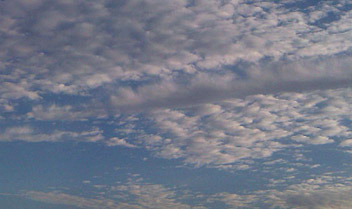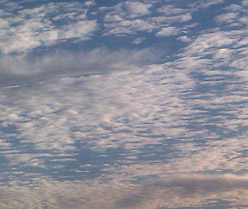At least five elongated hole punches puncture the clouds. Virga or fall streaks, precipitation that does not reach the ground, trails downwards from their centres. That the virga is composed of ice crystals rather than rain is evidenced by the bright sundog shining from the distant hole punch.
Hole punches are roughly circular or elongated holes in clouds with ice crystals falling out of their centre. They are thought to result from an instability causing supercooled droplets already in the cloud layer to suddenly convert to ice crystals. The ice crystals grow and fall out of the cloud. Areas with large crystals are in any case less opaque than a host of small droplets – we therefore see a hole.
A trigger for the instability might be disturbance by an aircraft. Another trigger could be seed crystals , ice crystals acting as nuclei, tumbling downwards from higher cloud or a contrail.
Clouds with supercooled droplets arise because water does not always freeze at zero degrees Celsius. If no nuclei are present on which ice crystals can grow, the cloud water droplets remain and cool to sub-zero temperatures. The condition is metastable in that ice is the more stable state. Introduce enough nuclei or otherwise disturb the cloud and ice crystals grow very rapidly at the expense of the droplets.
This is a normal condition. Rain can form that way from an initial formation of ice crystals coagulating into larger snowflakes which subsequently melt as they descend. What is strange is that in hole punches and their like, the supercooled droplet to ice transformation takes place only in small patches.
The lower image showing a very elongated hole is suggestive of an aircraft distirbance, either directly or via precipitation from its contrail.
|













